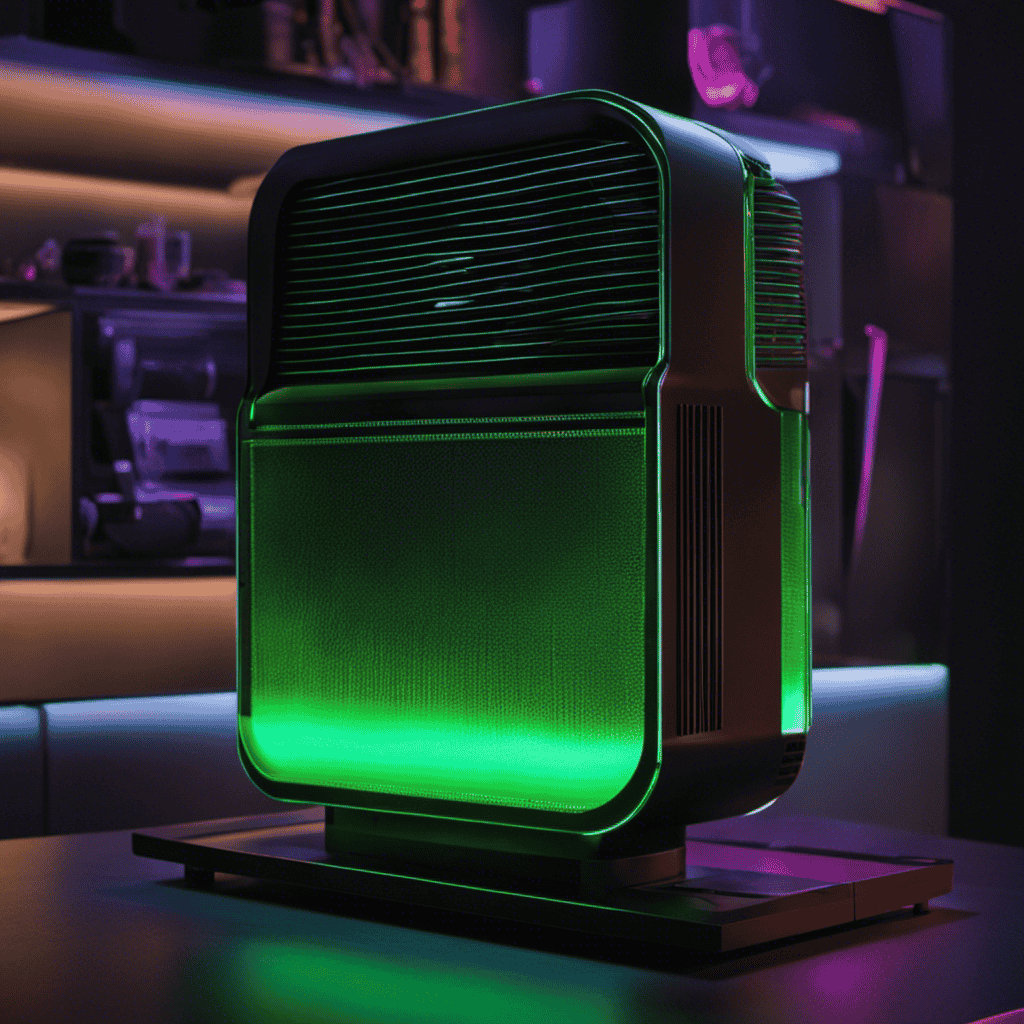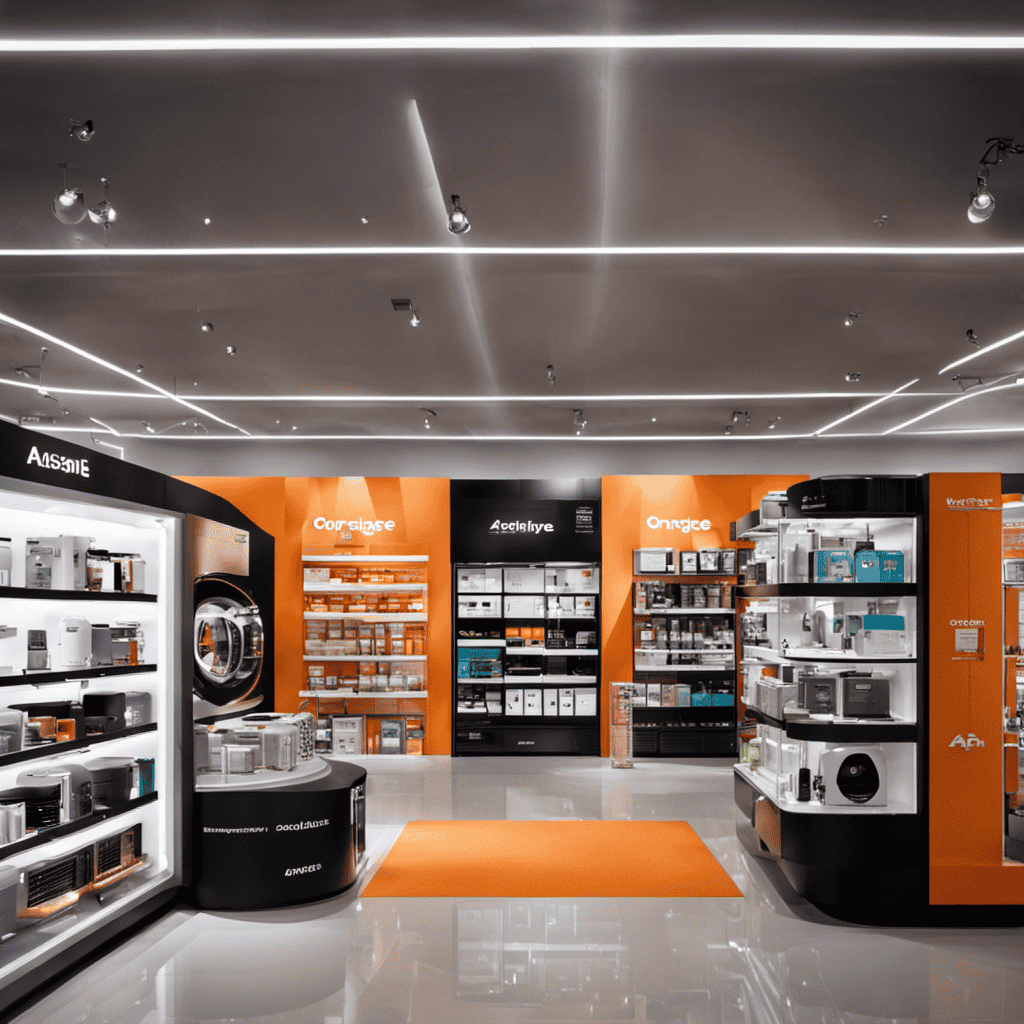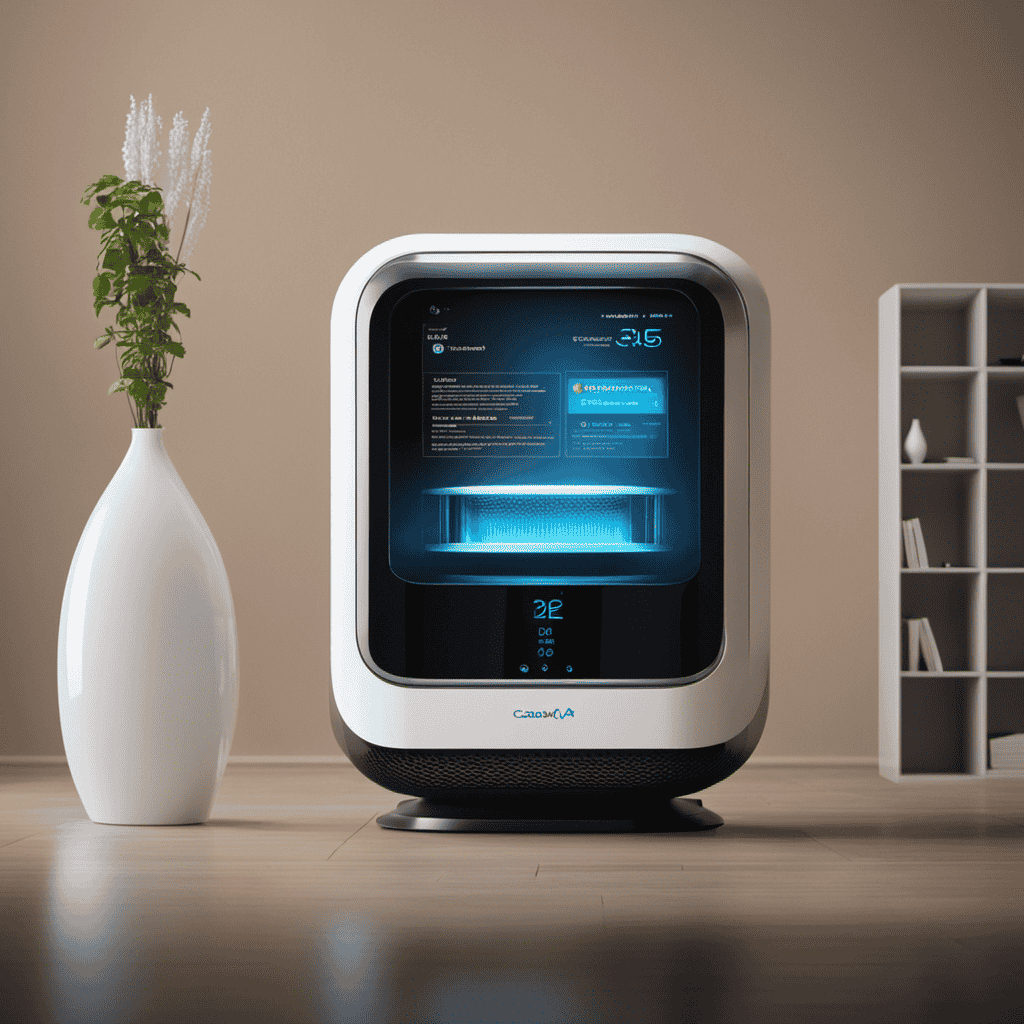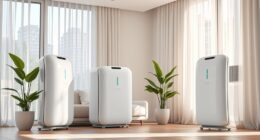Have you ever thought about the cost of an air purifier? With a plethora of choices available, it can be daunting to figure out where to begin.
In this article, I will explore the factors that affect the price of air purifiers, different types of air purifiers and their costs, as well as budget-friendly options and high-end luxury models.
Additionally, I will discuss the long-term savings and financing options available.
So, let’s dive in and find out how much is an air purifier really worth.
Key Takeaways
- The price of air purifiers is influenced by factors such as the cost of replacement filters, noise levels, initial cost, brand and model variations, and advanced technology and materials.
- Different types of air purifiers have varying costs related to filter lifespan, energy consumption, and maintenance expenses. It is important to consider these factors when budgeting for filters and energy bills, as well as long-term cost-effectiveness.
- Filter costs and lifespan vary for different types of air purifiers, including HEPA, activated carbon, electrostatic, UV-C, and ionic purifiers. It is crucial to consider the cost and longevity of filters when making an informed decision about purchasing an air purifier.
- Energy consumption variations exist among air purifiers, and energy-efficient models can reduce environmental impact and lower energy bills. Features such as timers and sensors can contribute to energy efficiency, making it beneficial to choose an air purifier that reduces energy consumption.
Factors That Affect the Price of Air Purifiers
When it comes to air purifiers, there are several factors that can affect their price.
One important consideration is the cost of replacement filters. Air purifiers require regular filter replacements to maintain their effectiveness in removing pollutants from the air. The cost of these replacement filters can vary greatly depending on the brand and model of the air purifier.
Additionally, noise level considerations can also impact the price of air purifiers. Some air purifiers are designed to operate silently, while others may produce noticeable noise levels. Those that offer quieter operation tend to be more expensive due to the advanced technology and materials used to reduce noise.
Therefore, when purchasing an air purifier, it is essential to consider not only the initial cost but also the ongoing expenses associated with replacement filters and the desired noise level.
Different Types of Air Purifiers and Their Costs
When considering the different types of air purifiers available, it is crucial to examine the associated costs. This includes those related to filters, energy consumption, and maintenance expenses.
The cost of filters can vary significantly depending on the type of air purifier and the specific model. It is important to consider this cost when budgeting for an air purifier, as filters may need to be replaced regularly to maintain optimal performance.
Additionally, energy consumption variations should be taken into account when comparing air purifiers. Certain models may consume more electricity than others, leading to higher energy bills over time. It is important to choose an air purifier that is energy-efficient to minimize long-term costs.
Lastly, maintenance expenses should also be factored in when evaluating the overall cost-effectiveness of different air purifiers. This includes the cost of replacing filters or conducting regular servicing. These expenses can add up over time, so it is important to consider them when making a purchasing decision.
Cost of Filters
You should consider the cost of filters when deciding on an air purifier. Filters are an essential component of air purifiers as they trap and remove pollutants from the air. However, filters have a limited lifespan and need to be replaced regularly. The cost of filters can vary depending on the type of air purifier and the specific filter it requires. To help you understand the cost comparison and longevity assessment of different filters, here is a table outlining the average lifespan and cost of filters for various air purifiers:
| Air Purifier Type | Average Filter Lifespan | Filter Cost |
|---|---|---|
| HEPA | 6-12 months | $20-50 |
| Activated Carbon | 3-6 months | $10-30 |
| Electrostatic | Washable | $0 |
| UV-C | 6-12 months | $15-40 |
| Ionic | No replacement needed | N/A |
As you can see, the cost and longevity of filters can vary significantly depending on the type of air purifier you choose. Considering these factors is crucial in making an informed decision. Now, let’s delve into another important aspect of air purifiers: energy consumption variations.
Energy Consumption Variations
The energy consumption of different air purifiers can vary significantly depending on the model and features. When it comes to energy efficiency, it is important to consider the environmental impact of air purifiers.
Energy efficiency refers to the ability of a device to perform its function while minimizing the amount of energy consumed. This is crucial in reducing carbon emissions and conserving energy resources.
A study conducted by the Environmental Protection Agency (EPA) found that air purifiers with higher energy efficiency ratings can save up to 30% of electricity compared to less efficient models. Additionally, energy-efficient air purifiers often incorporate features such as timers and sensors to optimize energy usage.
Considering the environmental impact is essential when choosing an energy-efficient air purifier that not only improves indoor air quality but also reduces energy consumption.
Maintenance Expenses
One way to save on maintenance expenses is by regularly cleaning the filters of your air purifier. Proper maintenance can help prolong the lifespan of the filters and reduce the need for costly repairs. It is recommended to clean the filters every 3-6 months, depending on the manufacturer’s instructions and the air quality in your home. Neglecting filter maintenance can result in decreased performance and increased energy consumption.
Here is a table that shows the estimated lifespan and average cost of replacement filters for popular air purifier brands:
| Brand | Lifespan of Filters (months) | Average Cost of Replacement Filters |
|---|---|---|
| Brand A | 6 | $20-30 |
| Brand B | 12 | $30-40 |
| Brand C | 18 | $40-50 |
| Brand D | 24 | $50-60 |
| Brand E | 36 | $60-70 |
Regularly cleaning and replacing filters can help maintain the efficiency of your air purifier and potentially save you money in the long run.
Budget-Friendly Air Purifiers: Options Under $100
As an expert in air purifiers, I’ve extensively researched the best budget options available on the market.
In this discussion, we’ll delve into the key points of finding the best budget air purifiers. We’ll focus on their performance under $100 and cost-effective filtration options.
Best Budget Air Purifiers
Looking for a budget-friendly air purifier? Check out these top choices that won’t break the bank.
When it comes to cost-saving tips and maintenance hacks for air purifiers, there are a few things to keep in mind.
First, consider the filter type and lifespan. Opting for an air purifier with a longer-lasting filter can save you money in the long run.
Additionally, some models offer washable filters, which can further reduce maintenance costs.
Another cost-saving tip is to choose an air purifier with adjustable fan speeds. This allows you to adjust the purification level based on the air quality, saving energy and extending the lifespan of the filters.
Lastly, regular cleaning and maintenance of the unit, such as wiping down the exterior and replacing filters as recommended, can help optimize performance and prevent costly repairs.
Performance Under $100
For those on a tight budget, you can find great performance options for under $100. When it comes to air purifiers, performance benefits are crucial. You want a device that effectively removes pollutants from the air, providing you with clean and fresh air to breathe.
Fortunately, many affordable air purifiers offer excellent performance. These devices often come equipped with high-efficiency particulate air (HEPA) filters, which can capture particles as small as 0.3 microns with an efficiency of 99.97%. This means that common allergens, dust, pet dander, and even some viruses and bacteria can be effectively removed from your indoor air.
Along with their performance benefits, these budget-friendly air purifiers also have low maintenance requirements, with filter replacements typically needed only once every six to twelve months.
Now, let’s explore some cost-effective filtration options.
Cost-Effective Filtration Options
When it comes to cost-effective filtration options, you’ll be pleased to know that there are several affordable choices available. As a researcher in the field of air quality, I have found that these cost-effective filter alternatives can help improve indoor air quality without breaking the bank.
Here are three affordable air cleaning options that offer effective filtration:
-
HEPA Filters: High Efficiency Particulate Air (HEPA) filters are known for their ability to capture 99.97% of airborne particles as small as 0.3 microns. These filters are widely available and can be used in standalone air purifiers or in HVAC systems.
-
Activated Carbon Filters: Activated carbon filters are effective in removing odors, volatile organic compounds (VOCs), and other harmful gases from the air. These filters work by adsorbing the pollutants onto the surface of the carbon, providing clean and fresh air.
-
UV-C Light Filters: UV-C light filters utilize ultraviolet light to kill bacteria, viruses, and other microorganisms. These filters are often used in combination with other filtration technologies to provide a comprehensive air cleaning solution.
Mid-Range Air Purifiers: What to Expect in the $100-$300 Range
You can expect to find a variety of features and options in mid-range air purifiers, typically priced between $100 and $300. These cost-effective models offer a great balance between price and performance.
When comparing the performance of mid-range air purifiers, it’s important to consider their CADR (Clean Air Delivery Rate) and ACH (Air Changes per Hour) ratings. CADR measures the speed at which the purifier can clean the air, while ACH tells you how many times it can fully clean the room air in an hour. Look for models with higher CADR and ACH ratings for better air purification.
Additionally, mid-range air purifiers often come with features like multiple fan speeds, automatic sensors, and filter replacement indicators. These features enhance convenience and ensure optimal performance.
Now, let’s explore high-end air purifiers: luxury models and their price tags.
High-End Air Purifiers: Luxury Models and Their Price Tags
In the previous subtopic, we discussed what to expect from mid-range air purifiers in the $100-$300 price range. Now, let’s shift our focus to the high-end air purifiers that offer luxury features and come with a heftier price tag.
-
Advanced Filtration Systems: High-end air purifiers often come equipped with multiple filtration stages, including HEPA filters, activated carbon filters, and even UV-C light technology. These features ensure the removal of a wide range of airborne pollutants, including allergens, dust, pet dander, and even volatile organic compounds (VOCs).
-
Smart Technology Integration: Luxury models often boast smart features like Wi-Fi connectivity and smartphone apps. This allows users to remotely control and monitor the air purifier, adjust settings, and receive real-time air quality notifications.
-
Enhanced Performance: High-end air purifiers are designed to cover larger areas and have higher Clean Air Delivery Rates (CADR). They are capable of purifying the air more efficiently and quickly, making them ideal for larger rooms or open floor plans.
When it comes to luxury air purifiers, the combination of advanced filtration systems, smart technology integration, and enhanced performance sets them apart from their mid-range counterparts.
The Cost of Energy Usage: How Much Will an Air Purifier Add to Your Electric Bill
With their luxury features, high-end air purifiers can significantly increase your monthly electric bill. It’s important to understand the cost of energy usage before investing in one of these models.
According to my research, the average power consumption of a high-end air purifier is around 50 watts per hour. Assuming you run it for 24 hours a day, that amounts to 1.2 kilowatt-hours (kWh) per day. Considering the average electricity rate of $0.12 per kWh, the daily cost of running a high-end air purifier would be approximately $0.14. Over a month, this would add up to around $4.20.
To save on energy costs, consider using the air purifier only when necessary, keeping it clean and well-maintained, and following energy-saving tips such as adjusting the fan speed or timer settings.
Maintenance Costs: Filters, Parts, and Repairs
Maintaining an air purifier can be costly, as filters, parts, and repairs can add up over time. Here are three key factors to consider when it comes to the cost of repairs and the lifespan of filters:
-
Cost of Repairs: Air purifiers, like any other electronic device, may require repairs at some point. These repairs can range in price depending on the specific issue and the brand of the purifier. It is important to factor in potential repair costs when budgeting for your air purifier.
-
Lifespan of Filters: Filters in air purifiers need to be replaced regularly to ensure optimal performance. The lifespan of filters varies depending on the type and brand of the purifier. Some filters may last up to six months, while others may need to be replaced every three months. It is essential to consider the cost of replacement filters when calculating the overall cost of ownership.
-
Quality and Warranty: Investing in a high-quality air purifier with a good warranty can help reduce the cost of repairs. A durable purifier with a longer warranty period is less likely to require frequent repairs, saving you money in the long run.
Considering the cost of repairs and the lifespan of filters is crucial to accurately determine the total cost of owning an air purifier. By factoring in these expenses, you can make an informed decision on whether an air purifier fits within your budget.
Now that we have explored the maintenance costs of air purifiers, let’s move on to the next section: comparing prices from different retailers to find the best deal.
Where to Buy Air Purifiers: Comparing Prices From Different Retailers
When looking to buy an air purifier, you can save money by comparing prices from different retailers.
Online retailers and local stores offer a wide range of options to choose from. According to my research, online retailers tend to have a larger selection of air purifiers compared to local stores. They also often offer competitive prices and discounts. However, it is important to consider the shipping costs when buying from online retailers.
On the other hand, local stores allow you to see and touch the air purifiers before making a purchase. They also offer the advantage of immediate availability, as you can take the product home with you right away.
It is recommended to check both online retailers and local stores to find the best deal for your air purifier purchase.
Online Shopping Tips: Finding Deals and Discounts on Air Purifiers
You can save money on air purifiers by searching for deals and discounts while shopping online. As a savvy shopper, I have found that there are several budget-friendly options available when it comes to air purifiers.
Here are three online shopping strategies that can help you find the best deals:
-
Comparison websites: Use comparison websites to compare prices and features of different air purifiers. These websites provide you with a comprehensive list of options, allowing you to choose the one that fits your budget and requirements.
-
Sign up for newsletters: Many online retailers offer exclusive deals and discounts to their subscribers. By signing up for newsletters, you can stay updated on the latest promotions and be the first to know about any special offers on air purifiers.
-
Use coupon codes: Before making a purchase, always check for coupon codes. Many websites offer promotional codes that can be applied at checkout for additional savings. Simply search for ‘air purifier coupon codes’ or visit coupon websites to find the latest discounts.
Secondhand Air Purifiers: Pros and Cons of Buying Used
When considering purchasing a used air purifier, there are several key points to consider.
Firstly, the reliability of a used purifier is crucial, as it may have been previously used and could have potential issues or malfunctions.
Secondly, the cost savings associated with buying a used purifier may seem enticing, but it is important to weigh these savings against the potential risks and drawbacks.
Lastly, there are health concerns that arise with using a used air purifier, as it may not effectively filter out harmful particles or could have accumulated pollutants over time.
Used Purifier Reliability
If you’re considering a used air purifier, it’s important to assess its reliability. Here are three key factors to consider when evaluating the reliability of a used purifier:
-
Age and usage: Determine the age of the purifier and how extensively it has been used. Older models may have worn-out parts or outdated technology, reducing their effectiveness. Additionally, if the purifier has been used in a highly polluted environment, it may have accumulated excessive pollutants, impacting its performance.
-
Maintenance history: Request information about the purifier’s maintenance history. Regular maintenance, such as filter replacements and cleaning, ensures optimal performance. Neglected maintenance can lead to decreased efficiency and potential breakdowns.
-
Brand reputation: Research the reputation of the brand and model you’re considering. Look for reviews, ratings, and customer experiences to gauge the overall reliability of the purifier.
Assessing these factors will help you make an informed decision and ensure that the used air purifier you purchase is reliable and effective.
Now, let’s explore whether the cost savings of buying a used purifier are worth it.
Cost Savings Worth It
Determining whether the cost savings are worth it involves considering factors such as the purifier’s age, maintenance history, and brand reputation. Conducting a cost benefit analysis and an affordability comparison can help determine if purchasing a used air purifier is a wise decision. To assist in this evaluation, I have provided a table below that compares the cost of new and used air purifiers, as well as their respective features and warranties.
| New Air Purifier | Used Air Purifier | |
|---|---|---|
| Cost | $200 | $100 |
| Features | HEPA filter, activated carbon filter, digital display | HEPA filter, activated carbon filter |
| Warranty | 2 years | None |
Considering the table, it is evident that a new air purifier offers more features and comes with a warranty, but it costs twice as much as a used one. If the used purifier is in good condition and has been well-maintained, the cost savings may outweigh the potential drawbacks. However, one should also consider the long-term maintenance costs and the potential need for replacement parts. Ultimately, it is important to weigh the cost savings against the potential risks and benefits before making a decision.
Health Concerns With Used?
To ensure your well-being, it is important to consider any potential health concerns associated with using a used air purifier. While they may seem like a cost-effective option, there are a few factors to keep in mind:
-
Filter Contamination: Used air purifiers may contain contaminated filters, which can harbor bacteria, viruses, and allergens. These contaminants can be released back into the air, compromising the device’s effectiveness in improving indoor air quality.
-
Mold Growth: Used air purifiers may have been exposed to moisture or damp environments, leading to the growth of mold. Mold spores released by the device can cause respiratory issues and allergies in individuals.
-
Warranty and Maintenance: Used devices may not come with a warranty or proper maintenance records. This can lead to potential reliability issues, inadequate filter replacement, and compromised performance over time.
Considering these potential health risks, it is advisable to thoroughly research and evaluate any used air purifier before making a purchase decision.
Are Expensive Air Purifiers Worth It? Analyzing Performance Vs. Price
Expensive air purifiers may not be worth the additional cost if their performance does not significantly outweigh that of more affordable options. To determine the cost benefit analysis of air purifiers, it is crucial to consider consumer reviews and compare the performance of different models.
Research-driven data can provide valuable insights into the effectiveness of air purifiers at removing pollutants from the air. Consumer reviews offer firsthand experiences that can help assess the overall satisfaction and performance of various air purifiers.
Long-Term Savings: How an Air Purifier Can Improve Health and Reduce Medical Expenses
By improving indoor air quality, an air purifier can help individuals save money on medical expenses in the long run. Here are three ways an air purifier can provide long-term benefits and be a cost-effective strategy:
-
Reducing respiratory illnesses: Air purifiers remove harmful pollutants like dust, pollen, and allergens from the air, which can trigger respiratory issues such as asthma and allergies. By breathing cleaner air, individuals are less likely to develop these conditions, leading to fewer doctor visits and medication expenses.
-
Preventing airborne infections: Air purifiers can effectively capture and eliminate bacteria, viruses, and germs from the air. This reduces the risk of spreading diseases like the flu or common cold within the household, resulting in fewer sick days and lower medical costs.
-
Minimizing long-term health risks: Prolonged exposure to indoor air pollutants can have severe health consequences, including respiratory diseases, heart problems, and even cancer. By investing in an air purifier, individuals can mitigate these risks, potentially avoiding costly medical treatments and improving their overall well-being.
Financing Options: Can You Finance an Air Purifier Purchase
Financing an air purifier purchase can be a viable option for those looking to improve indoor air quality without incurring a large upfront cost. Many reputable air purifier manufacturers offer financing options and affordable payment plans, making it easier for consumers to invest in these essential devices. By spreading out the cost over a period of time, individuals can enjoy the benefits of cleaner air without straining their budget.
Here is a table showcasing some popular financing options for air purifiers:
| Manufacturer | Financing Option | Interest Rate | Term Length | Minimum Purchase |
|---|---|---|---|---|
| Brand A | 0% APR for 12 months | 0% | 12 months | $200 |
| Brand B | Low monthly payments | Varies | 24 months | $150 |
| Brand C | Deferred payment plan | 5% | 18 months | $250 |
These options give consumers the flexibility to choose a payment plan that suits their financial situation. It’s important to review the terms and conditions of each financing option to ensure that it aligns with your needs and budget. Ultimately, financing an air purifier purchase can make it more accessible for individuals who want to improve their indoor air quality without breaking the bank.
Hidden Costs: Additional Features and Accessories to Consider
When considering the purchase of an air purifier, it’s important to take into account the additional features and accessories that may be necessary.
Essential add-ons such as replacement filters, remote controls, and air quality monitors can significantly impact the overall cost of owning and maintaining an air purifier.
Therefore, it’s crucial to carefully evaluate whether these accessories are worth the investment based on their functionality and long-term value.
Essential Add-Ons
To enhance the performance of your air purifier, you’ll want to consider essential add-ons. Here are three affordable options that can improve the effectiveness of your air purifier:
-
Pre-Filters: These are an important part of essential maintenance for your air purifier. Pre-filters capture larger particles like dust, pet hair, and pollen, preventing them from clogging the main filter. By regularly replacing pre-filters, you can extend the lifespan of your air purifier and maintain optimal performance.
-
Activated Carbon Filters: These filters are designed to remove odors, gases, and volatile organic compounds (VOCs) from the air. Activated carbon has a large surface area that can absorb and trap these pollutants, improving the overall air quality in your home.
-
UV-C Lights: UV-C lights emit ultraviolet radiation that can kill airborne bacteria and viruses. By installing a UV-C light unit in your air purifier, you can further enhance its ability to provide clean and healthy air.
Considering these essential add-ons will not only improve the performance of your air purifier but also ensure that it remains efficient in purifying the air in your home.
Now, let’s delve into the next section and explore the price of accessories.
Price of Accessories
If you’re interested in purchasing these essential add-ons, you’ll find that the price of accessories can vary depending on the brand and quality.
When it comes to the cost of maintenance for air purifiers, it’s important to consider the affordability options available. The overall cost of maintenance includes not only the initial purchase price but also the expenses associated with replacement filters and other accessories over time.
Research shows that the price of replacement filters can range from $10 to $100, depending on the brand and model of the air purifier. Some brands offer more affordable options, with lower-priced filters that still provide effective filtration.
Additionally, it’s worth considering the lifespan of the filters and how frequently they need to be replaced, as this can impact the long-term cost of maintenance.
Worth the Investment?
Whether or not it’s worth the investment ultimately depends on your individual needs and budget. Before making a decision, it’s important to consider the effectiveness of air purifiers and the long-term benefits they can provide.
Here are three key factors to consider:
-
Air purifier effectiveness: Research shows that air purifiers can effectively remove airborne pollutants such as dust, pollen, and pet dander. They can also help reduce indoor air pollution caused by smoke and volatile organic compounds (VOCs). Look for air purifiers with HEPA filters, as they are proven to be highly effective in capturing particles as small as 0.3 microns.
-
Long-term benefits: Investing in an air purifier can have several long-term benefits. Clean indoor air can improve respiratory health, reduce allergy symptoms, and create a more comfortable living environment. Additionally, air purifiers can help prolong the lifespan of electronic devices by preventing dust buildup.
-
Cost considerations: While air purifiers may have an upfront cost, they can be a worthwhile investment in the long run. Consider the potential savings on medical expenses due to improved air quality, as well as the value of creating a healthier living space for yourself and your family.
DIY Air Purifiers: Cost-Effective Alternatives to Commercial Models
You can save money by making your own air purifier instead of purchasing a commercial model. DIY air purifier designs have gained popularity due to their cost-effective nature and the ability to customize them according to individual needs.
Homemade air purifiers typically consist of a fan, a filter, and a housing unit. Various materials can be used for the filter, such as activated carbon, HEPA filters, or even homemade filters made from materials like coffee filters or furnace filters.
Research has shown that DIY air purifiers can effectively remove airborne contaminants, including dust, pollen, and allergens. However, it is important to note that the efficiency of homemade air purifiers may vary depending on the design and quality of materials used.
Regular maintenance and filter replacement are also crucial for optimal performance.
Frequently Asked Questions
Can You Finance the Purchase of an Air Purifier?
Yes, you can finance the purchase of an air purifier. There are various financing options available, and some of the best places to buy air purifiers with financing include appliance stores, online retailers, and home improvement stores.
What Are Some Hidden Costs to Consider When Purchasing an Air Purifier?
When purchasing an air purifier, it’s important to consider the hidden costs. These can include maintenance expenses, filter replacement, and long-term costs. Additionally, it’s crucial to check the warranty coverage for any unexpected expenses.
Are There Any Cost-Effective Alternatives to Commercial Air Purifiers?
Cost effective alternatives to commercial air purifiers include DIY air purifiers. These can be made using household items like a fan and a HEPA filter. They offer a budget-friendly option for improving indoor air quality.
What Are the Pros and Cons of Buying a Used Air Purifier?
When considering the pros and cons of used air purifiers, it is important to weigh factors such as warranty coverage, filter condition, and potential performance issues. However, buying a new air purifier offers the benefits of improved technology and peace of mind.
How Much Will an Air Purifier Add to Your Electric Bill?
An air purifier can significantly increase electricity cost due to its energy consumption. It’s important to consider the wattage and usage time of the device to estimate the impact on your electric bill accurately.
What Factors Should I Consider When Deciding on the Cost of an Air Purifier?
When selecting the right air purifier, consider factors such as the size of the room, the type of pollutants you want to eliminate, and your budget. Higher cost air purifiers often have better filtration systems, but may not necessarily be the best option for your specific needs.
Conclusion
In conclusion, after delving into the research and data surrounding air purifiers, it is clear that these devices are not only essential for improving indoor air quality but also come with a price tag.
However, investing in an air purifier is like opening a window to a world of fresh, clean air. It’s like a gentle breeze sweeping away the pollutants and allergens, leaving behind a sanctuary of pure tranquility.
So, don’t hesitate to embark on this journey towards healthier living and breathe in the revitalizing essence of an air purifier.










